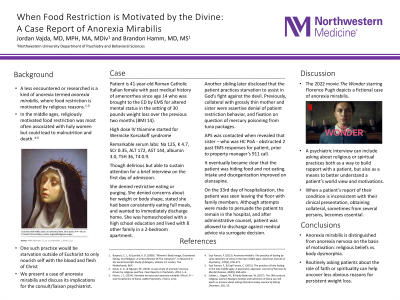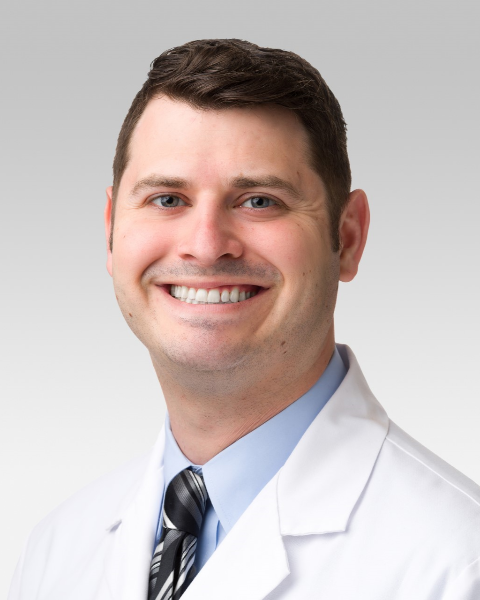Obesity, Nutrition, and Eating Disorders
(116) When Food Restriction is Motivated by the Divine: A Case Report of Anorexia Mirabilis


Jordan Vajda, MD, MPH
Resident Physician - Psychiatry
Northwestern University
Chicago, Illinois
Jordan Vajda, MD, MPH
Resident Physician - Psychiatry
Northwestern University
Chicago, Illinois
Brandon Hamm, MD, MS (he/him/his)
Assistant Professor
Northwestern University
Chicago, Illinois
Brandon Hamm, MD, MS (he/him/his)
Assistant Professor
Northwestern University
Chicago, Illinois
Presenting Author(s)
Co-Author(s)
Background
Anorexia nervosa is a well-known eating disorder. Less encountered or researched is a kind of anorexia termed “anorexia mirabilis,” where food restriction is motivated by religious reasons.1-2 We present a case of anorexia mirabilis and discuss its implications for the consult/liaison psychiatrist.
Case Presentation
Patient is 41 year old female with past medical history of amenorrhea since age 14 who was brought to the Emergency Department by family for altered mental status in the setting of 30 pounds weight loss over the previous two months. On presentation, BMI was 14 with the following notable labs: sodium 125, potassium 4.7, chloride 93, creatinine 0.35, calcium 7.6, ALT 172, AST 144, albumin 3.0, TSH 36, T4 0.9. Pt was intermittently delirious but able to sustain attention for a brief interview on the first day of admission. She denied restrictive eating or purging. She denied concerns about her weight or body shape, stated she had been consistently eating full meals, and wanted to immediately discharge home. She lived with parents and a sibling. A turning point came on the second day of hospitalization when another sibling called the patient’s medical team. They reported the patient had struggled with anorexia for years, that family with whom she lived lied about her eating patterns, and that the patient starved herself to assist in God’s fight against the devil. Adult protective services were contacted. It eventually became clear that the patient was hiding food and not eating. On the 33rd day of hospitalization, the patient was seen leaving the floor with family members. Although attempts were made to persuade the patient to remain in the hospital, and after consulting the hospital’s office of general counsel, patient was allowed to discharge against medical advice.
Discussion
Although less common, anorexia can be motivated not by concerns consistent with body dysmorphia but rather for religious reasons. A psychiatric interview can include asking about religious or spiritual practices both as a way to build rapport with a patient, but also as a means to better understand a patient’s world view and motivations.3 When a patient’s report of their condition is inconsistent with their clinical presentation, obtaining collateral, sometimes from several persons, becomes essential.
Conclusions
Anorexia mirabilis is distinguished from anorexia nervosa on the basis of motivation: religious beliefs vs. body dysmorphia. Routinely asking patients about the role of faith or spirituality can help uncover less obvious reasons for persistent weight loss.
References
1. Espi Forcen, Fernando. “Anorexia Mirabilis: The Practice of Fasting by Saint Catherine of Siena in the Late Middle Ages.” American Journal of Psychiatry 170, no. 4 (April 2013): 370–71. https://doi.org/10.1176/appi.ajp.2012.12111457.
2. Harris, James C. “Anorexia Nervosa and Anorexia Mirabilis: Miss K. R— and St Catherine of Siena.” JAMA Psychiatry 71, no. 11 (November 1, 2014): 1212. https://doi.org/10.1001/jamapsychiatry.2013.2765.
3. Sukkar, Isabella, Madeleine Gagan, and Warren Kealy-Bateman. “The 14th Century Religious Women Margery Kempe and Catherine of Siena Can Still Teach Us Lessons about Eating Disorders Today.” Journal of Eating Disorders 5, no. 1 (December 2017): 23. https://doi.org/10.1186/s40337
Presentation Eligibility: Not previously published or presented
Diversity, Equity, and Inclusion: Eating disorders, including anorexia, disproportionately affect women. In this case report of anorexia mirabilis in a female patient, we attend to a rare sub-type of anorexia that has historically affected women to a much greater degree than men. By giving voice to this population of patients, we are centering a stigmatized and often misunderstood experience.

